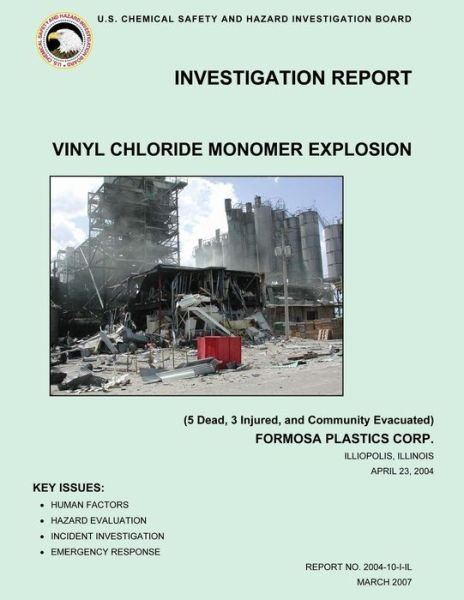
Tell your friends about this item:
Investigation Report: Vinyl Chloride Monomer Explosion: (5 Dead, 3 Injured, and Community Evacuated)
U S Chemical Safe Investigation Report
Investigation Report: Vinyl Chloride Monomer Explosion: (5 Dead, 3 Injured, and Community Evacuated)
U S Chemical Safe Investigation Report
Publisher Marketing: On April 23, 2004, an explosion and fire at the Formosa Plastics Corporation, Illiopolis, Illinois, (Formosa-IL) polyvinyl chloride (PVC) manufacturing facility killed five and severely injured three workers. The explosion and fire destroyed most of the reactor facility and adjacent warehouse and ignited PVC resins stored in the warehouse. Smoke from the smoldering fire drifted over the local community, and as a precaution, local authorities ordered an evacuation of the community for two days. As of the date of this report, the facility is shut down and has not been rebuilt. Vinyl chloride monomer (VCM), a highly flammable chemical and known carcinogen and the primary raw material in the PVC manufacturing process, was the fuel for the explosion and initial fire. Formosa- IL used VCM to manufacture PVC resins. Formosa-IL, a wholly owned subsidiary of Formosa Plastics Corporation, USA (FPC USA), bought the Illiopolis facility from Borden Chemical and operated it for approximately two years before the incident. The U. S. Chemical Safety and Hazard Investigation Board (CSB) determined that this incident occurred when an operator drained a full, heated, and pressurized PVC reactor. The CSB believes that the operator cleaning a nearby reactor likely opened the bottom valve on an operating reactor, releasing its highly flammable contents. Opening the bottom valve on the operating reactor required bypassing a pressure interlock. The safeguards to prevent bypassing the interlock were insufficient for the high risk associated with this activity. Two similar incidents at FPC USA PVC manufacturing facilities highlight problems with safeguards designed to prevent inadvertent discharge of an operating reactor. Two operators working with the shift supervisor attempted to manage the release, did not evacuate, and subsequently died. The CSB determined that facility emergency procedures for evacuation were ambiguous and that facility staff had not conducted a large release emergency drill in more than 10 years.
| Media | Books Paperback Book (Book with soft cover and glued back) |
| Released | August 1, 2014 |
| ISBN13 | 9781500502195 |
| Publishers | Createspace |
| Pages | 62 |
| Dimensions | 216 × 279 × 3 mm · 167 g |

